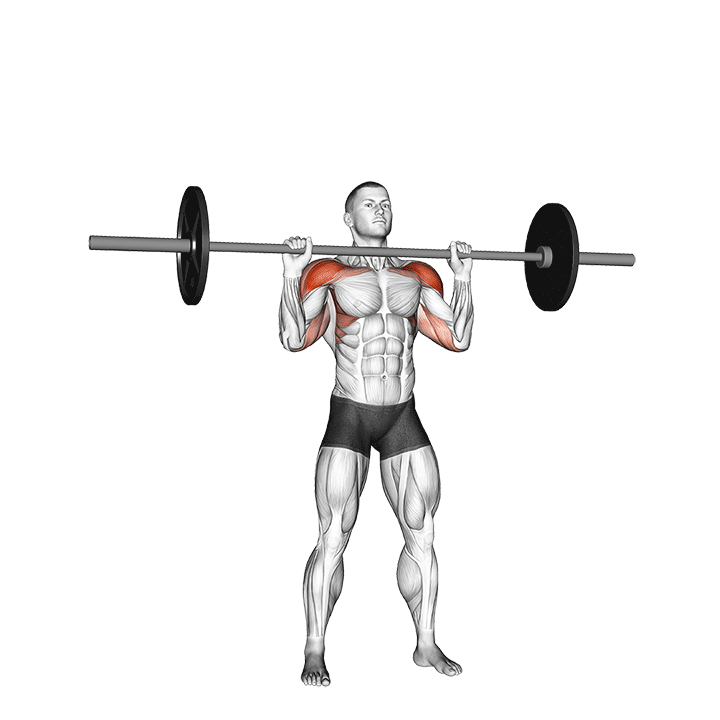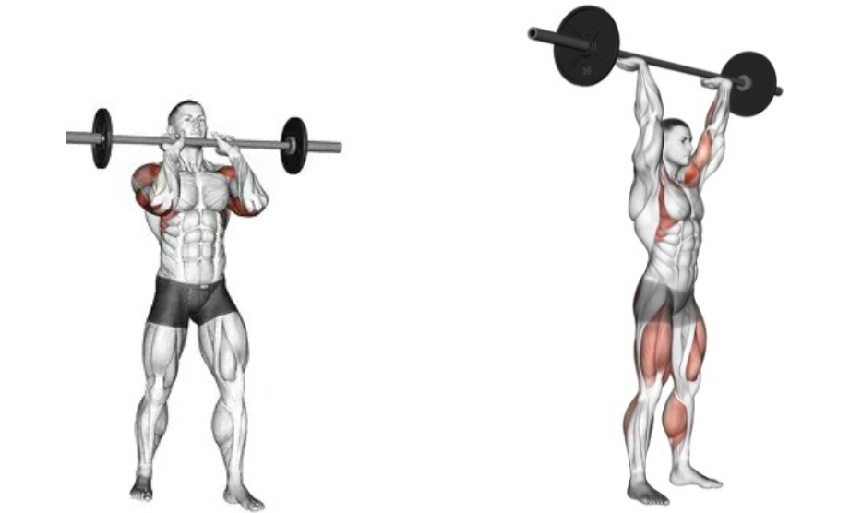The barbell strict press used to be one of those lifts I just ignored. Everyone around me was either benching heavy or going hard on push presses. So I figured, “Why bother pressing a bar overhead without any leg drive?”
But eventually, I hit a wall. My overhead strength stopped improving. My posture? Slouched. My shoulders? Weak. I knew I had to change something.
That’s when I gave the strict press a real shot. No cheating, no momentum—just me and the bar. It humbled me fast. Way harder than it looks, but also way more effective than I expected.
Now it’s one of the main lifts in my program. It’s helped me build actual shoulder strength, fix imbalances, and even carry myself better. Honestly, I wish I started it sooner.
Why the Strict Military Press Barbell Is My Go-To Overhead Lift
The barbell strict press is hands down the best lift I’ve used to build raw, grind-it-out overhead strength. If you’re looking for pure shoulder strength, the strict press is king.
At first, I wasn’t sold. It looked boring. Just standing there pressing a bar? But once I stuck with it, everything changed.
Here’s what made it a staple in my training:
- It forces your shoulders, triceps, and core to do all the work. No bounce. No momentum.
- I actually felt stronger—more solid, more stable.
- My posture improved, especially my upper back and neck.
- And surprisingly, it helped me get better at other lifts like push presses and jerks.
Honestly, once I started pressing strict, my entire upper body leveled up.
Strict Press vs Other Overhead Presses What I Noticed
Here’s how the strict press stacks up against other overhead variations I’ve tried:
| Press Variation | What It’s Good For | Why I Still Pick Strict Press |
|---|---|---|
| Strict Military Press | Pure shoulder + triceps strengthCore stability | No cheating. Builds real, grindy strength. |
| Push Press | Moving heavy weight fastMore total-body power | Great for overload, but too much leg drive. |
| Dumbbell Press | Fixing side-to-side imbalancesShoulder control | Nice for variety, but can't load it up as much. |
| Z Press | Core crush + shoulder lockout strength | Fun challenge, but harder to progress consistently. |
| Seated Press | Isolation, less fatigue | Misses out on core + full-body tension. |
So yeah, I still mess with other presses. But if I had to pick one for true upper body strength? Strict press wins. Every time.
If you’re digging into overhead press styles and want to see how different barbell variations actually feel and work, I put together a full breakdown of my 5 Best Barbell Strict Press Variations—definitely worth checking out if you’re looking to switch things up or bust through a plateau.
How to Barbell Strict Press the Right Way
When I started, I made all the classic mistakes—arching my back, flaring my elbows, pressing too far forward.

Here’s the setup and cues that helped me most:
Step-by-step:
- Stand tall – feet shoulder-width, squeeze your glutes.
- Grip the bar – just outside shoulder-width, wrists stacked.
- Elbows slightly forward – not flared out.
- Take a deep breath – brace your core hard.
- Press straight up – bar close to your face, move your head back slightly.
- Lock it out – biceps to ears, don’t lean back.
Cues that stuck:
- Push yourself away from the bar.
- Zip up your ribcage.”
- Squeeze your glutes before you press.
Common Mistakes I Made These Too
- Leaning back too far – you’ll wreck your lower back. Fix: tight glutes and core.
- Pressing away from the body – bar path should be straight. Fix: film yourself.
Letting elbows flare – keep them slightly in front of the bar.
I fixed these by dropping weight and dialing in form. Way more effective long term.
What’s a Good Strict Military Press Number?
When I first got into the strict military press barbell, I had zero clue what a “good” number was.
Was I weak? Strong? Somewhere in between? Reddit threads helped, but even then, the numbers were all over the place.
So I did some digging—and here’s what I learned.
The Big Questions I Had:
- How much should I be pressing for my size?
- What’s considered “strong” vs just okay?
- Do men and women have different standards?
- What should a beginner aim for?
- What’s elite-level pressing?
These were the things I needed answers to. And once I found some rough benchmarks, my training got way more focused.
Strength Standards That Actually Help
These are general guidelines—not powerlifting rules. But they’re super helpful for figuring out where you stand.
I’m currently pressing about 65% of my bodyweight, and yeah… it’s been slow going, but I feel way stronger now than when I started.
Strength Standards by Experience Level
| Strength Level | Men | Women | ||
|---|---|---|---|---|
| Weight | Bodyweight Ratio | Weight | Bodyweight Ratio | |
| Beginner | 69 lb | 0.40x | 31 lb | 0.20x |
| Novice | 101 lb | 0.55x | 50 lb | 0.35x |
| Intermediate | 142 lb | 0.80x | 76 lb | 0.55x |
| Advanced | 189 lb | 1.05x | 106 lb | 0.75x |
| Elite | 241 lb | 1.35x | 140 lb | 1.00x |
These numbers aren’t set in stone, but they give you a solid target. If you’re pressing half your bodyweight, you’re on track. If you’re pressing bodyweight overhead, you’re strong. Period.
Now I use this chart to track progress without obsessing over PRs. Progress = progress.
Curious if your numbers are “good” or just gym-average? I broke it all down by gender, bodyweight, and experience level in this full guide: Strict Press Strength Standards for Men and Women (lb). Super helpful if you want to set realistic goals or just compare without second-guessing yourself.
If you’ve been avoiding the strict military press because it’s hard or slow-progressing, I get it. But if you want stronger shoulders, better posture, and more control overhead—this lift delivers. You won’t regret adding it to your routine.

Hi, I’m the editor here at Leadman Fitness. We’re a manufacturer focused on producing top-quality barbells, plates, kettlebells, dumbbells, and strength training gear. I’ve been into sports and fitness for years, and I know my way around all kinds of gym equipment—both from using it and helping create it.
I spend a lot of time understanding the real problems people run into in the gym—whether it’s beginners trying to pick the right gear or experienced lifters looking for something more durable. I stay in close touch with our production team and talk directly with other equipment makers, so we’re always improving based on what real lifters and coaches are looking for.
What I share comes from hands-on experience—stuff that actually helps people train better, not just in theory, but in real gyms.
